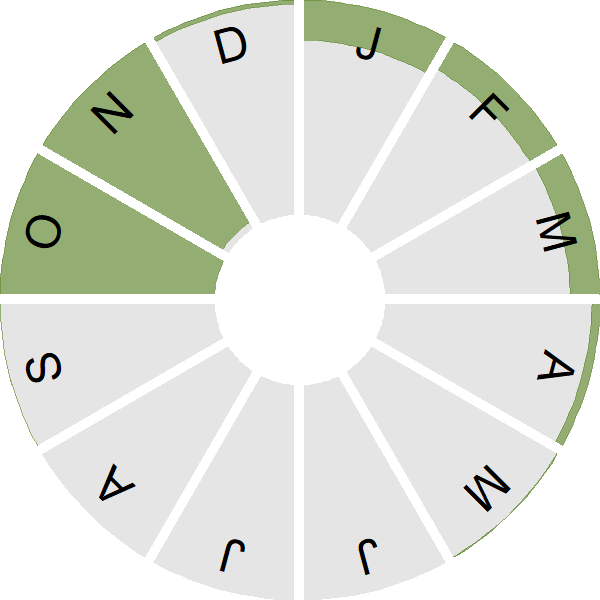Pallas's Warbler
Introduction
Still a magical sight for anyone who finds one (they are commonest on the east coast in October/November), these tiny birds will have travelled more than 3,000 miles from breeding grounds in the Far East.
Key Stats
Identification
Songs and Calls
Call:
Status and Trends
Conservation Status
Population Size
Population Change
Pallas's Warbler is a scarce migrant, seen predominantly in late autumn, mostly along the east coast; it is a species that is becoming more common and the occasional overwintering bird has led to individuals establishing territories in the breeding season before departing for more traditional breeding grounds [White & Kehoe 2024; Eaton & the Rare Breeding Birds Panel 2023a].
Distribution
Pallas's Warblers are rare late-autumn visitors from Siberia. During 2007–11 they were recorded from 58 10-km squares in winter, with 52 of these involving sightings in November only. The bulk of the records were from the North Sea coast between Aberdeenshire and north Norfolk. In contrast, several of the records in English south-coast counties were made in midwinter.
Occupied 10-km squares in UK
2007/08–10/11
or view it on Bird Atlas Mapstore.
2008–11
or view it on Bird Atlas Mapstore.
Distribution Change
Change in occupied 10-km squares in the UK
from 1981–84 to 2007–11
or view it on Bird Atlas Mapstore.
Seasonality
Pallas's Warbler is a scarce autumn passage migrant with most birds arriving in October and November; some birds have wintered and there are occasional spring records.
Weekly pattern of occurrence
The graph shows when the species is present in the UK, with taller bars indicating a higher likelihood of encountering the species in appropriate regions and habitats.

Movement
Britain & Ireland movement
Foreign locations of birds ringed or recovered in Britain & Ireland
Dots show the foreign destinations of birds ringed in Britain & Ireland, and the origins of birds ringed overseas that were subsequently recaptured, resighted or found dead in Britain & Ireland. Dot colours indicate the time of year that the species was present at the location.
- Winter (Nov-Feb)
- Spring (Mar-Apr)
- Summer (May-Jul)
- Autumn (Aug-Oct)

Biology
Survival and Longevity
Survival is shown as the proportion of birds surviving from one year to the next and is derived from bird ringing data. It can also be used to estimate how long birds typically live.
View number ringed each year in the Online Ringing Report.
Biometrics
Wing length and body weights are from live birds (source).
Wing length
Body weight
Ring Size
Classification, names and codes
Classification and Codes
- Order: Passeriformes
- Family: Phylloscopidae
- Scientific name: Phylloscopus proregulus
- Authority: Pallas, 1811
- BTO 2-letter code: PA
- BTO 5-letter code: PALWA
- Euring code number: 12980
Alternate species names
- Catalan: mosquiter reietó
- Czech: budnícek zlatohlavý
- Danish: Fuglekongesanger
- Dutch: Pallas' Boszanger
- Estonian: kuld-lehelind
- Finnish: hippiäisuunilintu
- French: Pouillot de Pallas
- German: Goldhähnchen-Laubsänger
- Hungarian: királyfüzike
- Icelandic: Kollsöngvari
- Irish: Ceolaire Pallas
- Italian: Luì di Pallas
- Latvian: Sibirijas kaukitis
- Lithuanian: nykštukine pecialinda
- Norwegian: Fuglekongesanger
- Polish: swistunka zlotawa
- Portuguese: felosa-de-pallas
- Slovak: kolibiarik králikovitý
- Slovenian: kraljicica
- Spanish: Mosquitero de Pallas
- Swedish: kungsfågelsångare
- Welsh: Telor Pallas
More Evidence
More evidence from Conservation Evidence.com
Partners
Citing BirdFacts
If you wish to cite particular content in this page (e.g. a specific value) it is best to use the original sources as linked in the page. For a more general citation of the whole page please use: BTO (20XX) BirdFacts Species: profiles of birds occurring in the United Kingdom. BTO, Thetford (www.bto.org/birdfacts, accessed on xx/xx/xxxx).

